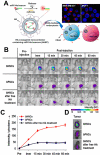miRNA nanotherapeutics for cancer
- PMID: 27815139
- PMCID: PMC5309208
- DOI: 10.1016/j.drudis.2016.10.014
miRNA nanotherapeutics for cancer
Abstract
MicroRNAs (miRNAs) are noncoding RNA molecules that regulate gene expression through diverse mechanisms. Increasing evidence suggests that miRNA-based therapies, either restoring or repressing miRNA expression and activity, hold great promise. However, the efficient delivery of miRNAs to target tissues is a major challenge in the transition of miRNA therapy to the clinic. Cationic polymers or viral vectors are efficient delivery agents but their systemic toxicity and immunogenicity limit their clinical usage. Efficient targeting and sustained release of miRNAs/anti-miRNAs using nanoparticles (NPs) conjugated with antibodies and/or peptides could reduce the required therapeutic dosage while minimizing systemic and cellular toxicity. Given their importance in clinical oncology, here we focus on the development of miRNA nanoformulations to achieve enhanced cellular uptake, bioavailability, and accumulation at the tumor site.
Copyright © 2016 Elsevier Ltd. All rights reserved.
Figures



References
Publication types
MeSH terms
Substances
Grants and funding
LinkOut - more resources
Full Text Sources
Other Literature Sources

